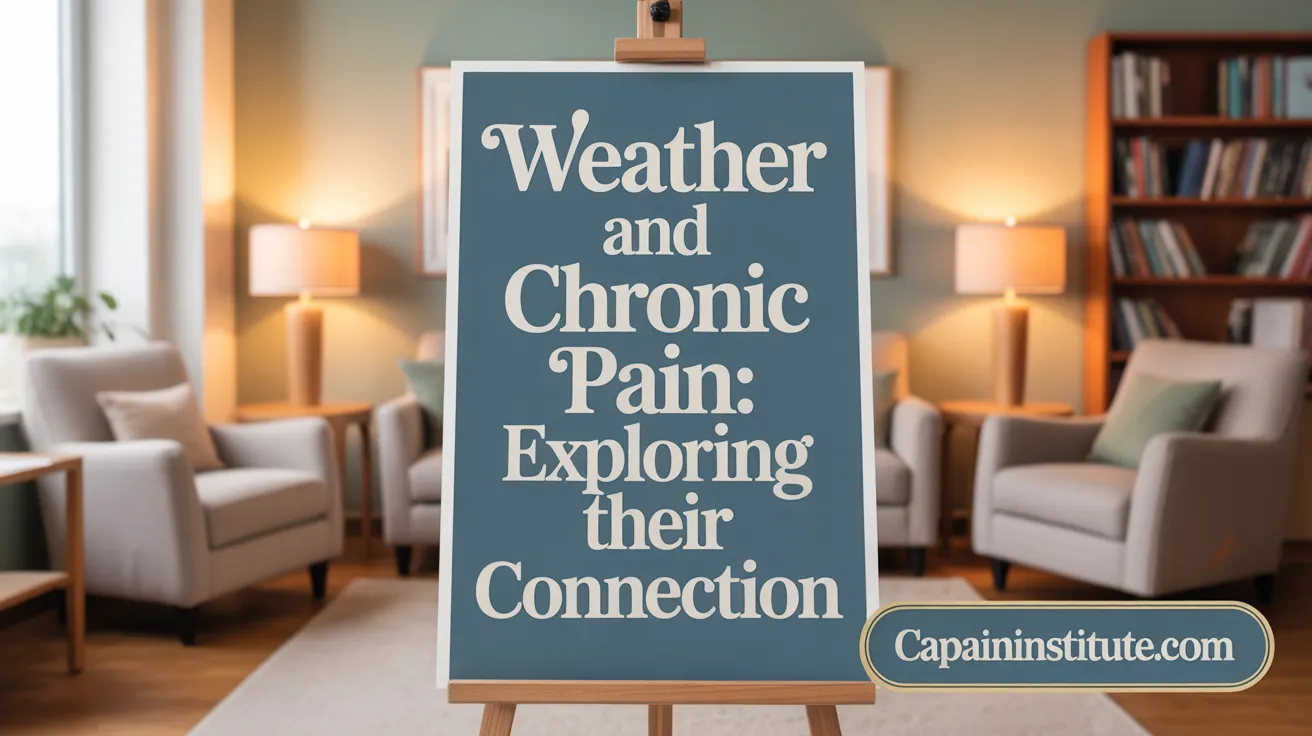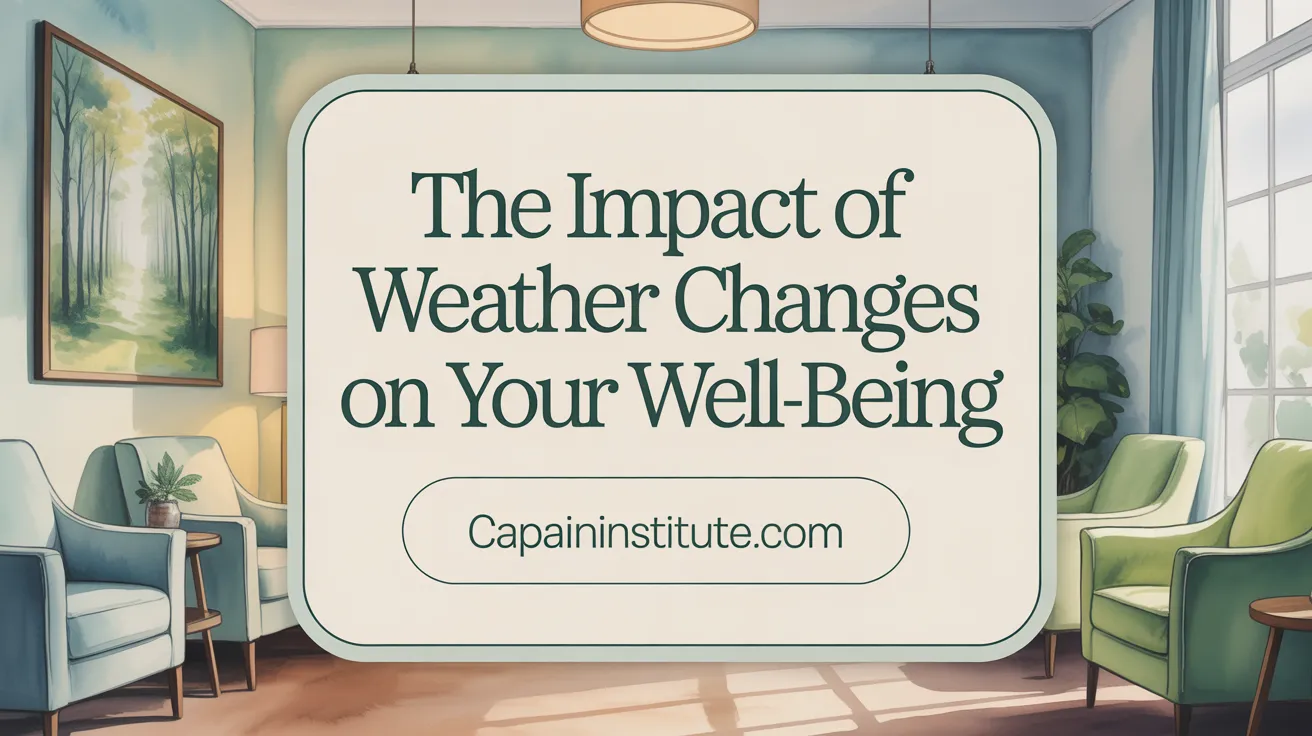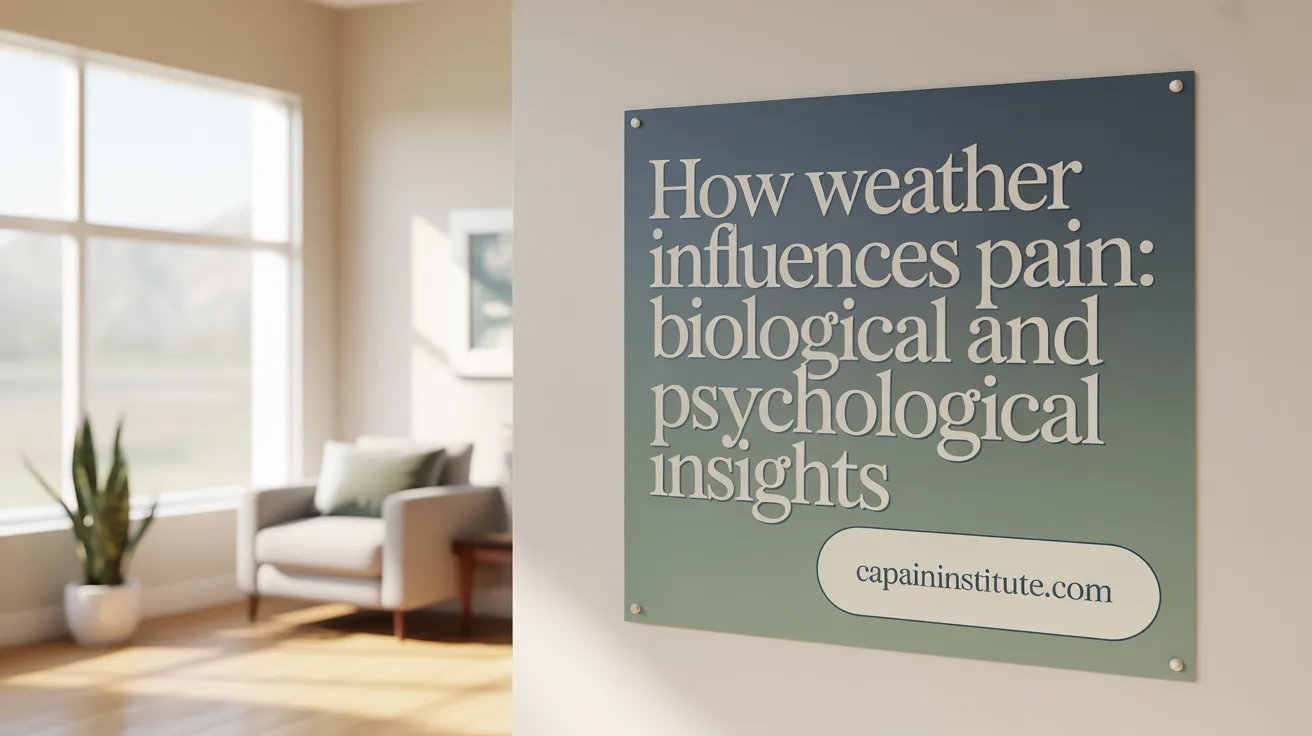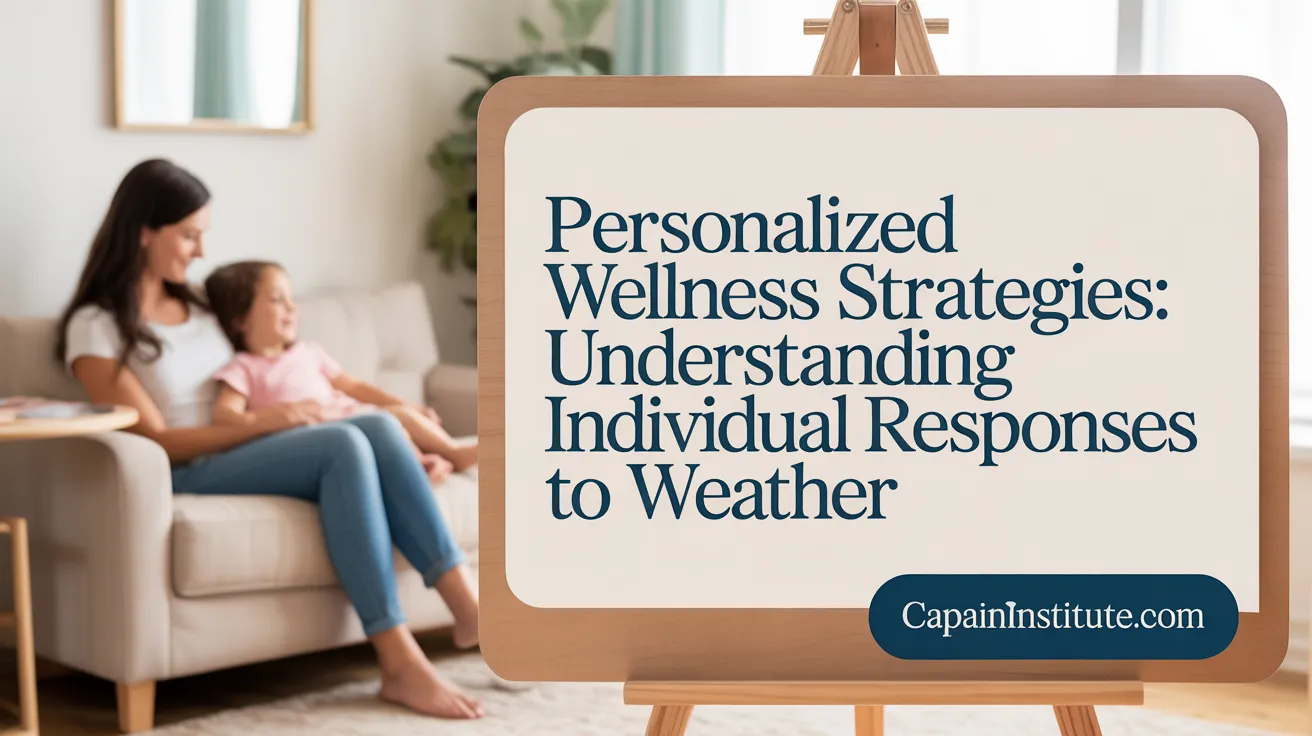Understanding the Weather-Pain Connection
Chronic pain sufferers often report that changing weather conditions influence their pain severity and tolerance. From fluctuations in temperature to shifting barometric pressure and humidity, environmental conditions interact with the body's physiological systems in complex ways. This article explores how various weather factors affect chronic pain, the underlying scientific mechanisms, individual sensitivities, and practical strategies to manage weather-related pain exacerbations.
<!-- VIDEO:eyJsaW5rIjoiaHR0cHM6Ly93d3cueW91dHViZS5jb20vd2F0Y2g/dj1pS2Zyclg4dUxnRSIsImltYWdlVXJsIjoiZGF0YTppbWFnZS9qcGVnO2Jhc2U2NCwvOWovNEFBUVNrWkpSZ0FCQVFBQUFRQUJBQUQvMndDRUFBa0dCd2dIQmdrSUJ3Z0tDZ2tMRFJZUERRd01EUnNVRlJBV0lCMGlJaUFkSHg4a0tEUXNKQ1l4Sng4ZkxUMHRNVFUzT2pvNkl5cy9SRDg0UXpRNU9qY0JDZ29LRFF3TkdnOFBHamNsSHlVM056YzNOemMzTnpjM056YzNOemMzTnpjM056YzNOemMzTnpjM056YzNOemMzTnpjM056YzNOemMzTnpjM056YzNOLy9BQUJFSUFGTUFsQU1CRVFBQ0VRRURFUUgveEFBYkFBQURBUUVCQVFFQUFBQUFBQUFBQUFBREJBVUdBZ0VBQi8vRUFEc1FBQUVEQXdJRUJBUURCd01GQVFBQUFBRUNBd1FBQlJFU0lRWVRNVUVpVVdGeEZJR1JvU015c1FjVlFsTEI0ZkJpZ3FJelZKTFI4U1QveEFBYkFRQUNBd0VCQVFBQUFBQUFBQUFBQUFBRUJRSURCZ0VBQi8vRUFEY1JBQUVEQWdRQ0NBVURCQU1CQUFBQUFBRUFBZ01FRVFVU0lURkJVUVlUWVhHQmthR3hGQ0xCMGZBeVF1RVZJMUx4RmpOeUpQL2FBQXdEQVFBQ0VRTVJBRDhBa0hjWTdldGJ4WXhKeUxiR2V5UWt0cVBkRzMycUpZQ2lZNnVWbkcvZXBFcUV0aDNscFVIRkhjQklPZnBTK3ByS2VtZGxrZFlwbERPSlJleThSYjV5eWtJaFNWRlN0QUFhVVNWWXpqcDF4dmlnWFk3UU4vZXI5ZVI4a2NXTzZtSzVLL2Qwb1Iyd3BTM1ZORUpTRTUxYm55d2ZwUXp1a3RBSGhnZHFlR25IeFhjcjdac3BzbUxKWUwzYzBLazJpSXQxRGE5Q2xoYVVqT0FjZUlqc1JWZFgwcHBLTitTWFEvbks2NElYVHRObTNDdHMyaS9HMHUzRjJFeTJ3d2x3dUxXOEUva0pDdkR2dmxKRkRPNmFRQ1lRdGJkeHRiZmp0d1FuOUtlUVhnMkM3bThNM240V0VaTFVBSm5QTnRJVHpGRlNTc1pCTzIyQjFvYi9BSnF5UXZhMW42UVNmRGxyNUsxdUZ5UmxyZzdkWmU2VzE2MnpKTVp4U1hQaDNTMHR4dk9uVVBldEJnMWZKWDAvWHVGZ2R2eTU1aFdFNVpER1RxRUNISlhGZUMwYmpvcFBtS2NOTmlvVFFpVnRpcmo3YlUrSDRDQ0R1aFhrYXRJRGdsVWJuVTh1dml1dUZiZFpuQzYvZTdvWWJyYXRMVFNDa0t6M0tzanAyeFN5cHFKNG5nUk12NEZPc2tjckxFNkZWYmh3by9jMzJHTGZLWld5NGRUVWwwRktTTUh0dVNmYlkxRCtyUVBqSlA2Z2JFRFd4UXRQU3ZpbUxRYmdqZGFxM2NGczJPR3NXOHR6SkxoL0VWTVNNRVlJd2tBZUhPU092NlZtc1VrcXF4N1hNa0xBT0RTUnJjRUh0c1Jwb24xSEhSaHgrSmJjYzk3TDh6NHRqc3RjVVRtSXFTbElkeHBJSXdvOWRpQnRrN1kyeGpCTmFIQlhWTHFDSTFYNjdhOGU3VUUzTnR6dmU5d0V2bkViSG5KK2tJMTBkRWFDR2tiRlFDQjZEdjhBNTYwNWNiQkpLVnZXVFpqM3FYYm9wbFA0SS9EVHVzLzBxdHJibE1LaWJxbVg0OEZYdU13Ulc5TGVPYW9lRWZ5K3RXT2RaTHFlQXl1dWRsbnlTU1NTU1QxSjcxU25GcmJMU05UWXp1eUhrNThqc2F2RGdVamZUeXMzQ1lxU3BWbmdOOTZMeEhPV0ZwRWY0RXV1NVR1QWsrRVorWlB5cjVsMDdoYVhzSk4zRWdEcy9MTFFZTThnSGt0THc0NlpscnMwMjZTdFUwODZlVTZBTll3VVoyMkFDVnBIMHJHVnplcm1saWhiOHZ5czd1UHFRVTNoT1pyWFBPdXAraXpuR01sRFBDOXJocXViN0U5eUloeGNKc0VKZjVoR3NyUFRBd3JBNzAxd21FeTFzamhHQ3pOWU9QQzJndDZJV3FlR3dnRjFqYlpWL3dCbjdMVEhDOXRDeXNPT3V2eWs0VmhKMDVUbFhwakgyb1BHNUhTVjhwYnRvUFBYVDg1cTZqQUVUZkVwUzlOUnJuQzRldHMyTEljbnlnaDhLYjJhYkxpZ3B3cTM2NDFZcXlrZEpCSlBQRzRCamJqWGMyRmhiMHVveUJyMnNhNGFueTFXbGxSM0g3cGJPYUFFb3VEandTQ0Q0RXRLU25wOGpTcU40WkZKbC93QThTNEZFdWJkemI4L292eTV4YTEzQ1kzTVlkYWVlZVcrcHQ1R2trS1VTTmo2VjlqNk16d21rRUVldVVhbmh5V1VybXZFcGtPaWszQzJGdkxzWUZTT3BSL0wvYXRBNWx0UXJhZXJEdmxmdWcyMmFZcm1sUnkwbytJZVhyVVd1c3JhbW42MXR4dXRidy9HVzVlRzF0cGNNZDNkMG8xYWNwQktUdDZFamZ6cGRqVW9ocFhTTk92cnJwc05WUlJ1Y2Y3Wkg1eVc0bW9RNDBnckc0MndRUldNd2FjUHFIUld1Q0xuY0c0MEZyNm5UVHdSMHVaakE0R3gyU2w1WmJhczdyckN0RHJRMUJhVG52djlhRXdtcHFuNHkyT3BiOHJ5UmxJdHBZMnQzVzkwWFd5TkZObWhkcUIrZWEvS1lxbFRMd3AxeFJXcldWcVVmVHAvU3ZwMGJBeXpXaXdDVzFEeUlibmNybTZ2R1JPNVRmaTBlRUFkejNxVHpjcU5Jd1J4WFBGVUFXN1hCR3JCV2V3L2lWLzZxZjZRZ3ptcXBkTnZvb3hMc3A4bkJXNHM5QlZXcEthREpFemtBcXJObmI1WTV5bEZmZlNkcXNFZk5MMzF6czN5alJSYXFUTkVhZWRhUDRUaWtlZ08xZEJLaTZOanYxQldyTnhDYmZFdXlIV2xPeUowYjRkRGdJVHl4dmsrdlVmU3NmanVFVk9JVmtjalI4ckNEMzI4VktBaUZybXRidXFKNDJLWUNZakZ2Q0VvdHBnSVdYdDA1R0N2cDEyRzNwU3B2UktwZEoxamorL053OEJ1cnZpWEJ0ZzNoYmRmWHppVnppTmh0bFVTMnhsSVVraHhKSmMwcHpoT1NPbTlHNFowVG1vNWVzNnkvWmZTL08xdDBOVjFqbnR5bG5paXg3dmVHWVVlS3k1RFEyekZYRlFRMm9uUXZHbzlldmhHL3ZWeDZHTmU4dmUvVWtIeEczZ3FQNnM1b0RRTmhaTU9jUmNRclEwazNKdHRMUkJSeTR5UENRTWQ2a3pvUFJ0dVhPdmZ2KzY0Y1ltT3dVVlZ5dmtGdENZdHpXRzJ5c3BDQ2xLaHJPcFhidWQrdEV5ZEY4UEpKa0lON2VtZ1U0YTl4MHVRb3N5YkttU2pKbHlISFh6akxpMVpWdDAzcGhRd1VPSHRMWVhBRHZIMFZ6bkIxeTQzdW5ZVjNJSVJLMzhsanI4eFIvOEFVNllidkNYelVqVDgwZmt1WnNacVFkY0pMaW5GS3hvUzBvaFI5TnV0RFM0eFFOMXorNnZwdXZIeXZHaTBYQmNxNVcxYjBXUmJMZzQwVWhhVW9qS0trNVBxTmdjSDcwanhIRjZDWEs5c2c1YmhNSXN6U2ZsT3FyUGNWeHc2V1hBL0VrZ2xLMkhtOEVIdDJ4K2xENFZoN2FtcGRWbXp4cGtOOXZEbjI2OFZSTTl4QnZwelJuYnV6TnhiRjdvZDArTkswWldUditVWlVrRHpJcHBSVUVrZFM2cm1hQS9XM0d3MjNzT0hBRzJxRmxjSFFnTk9oV1JndWlaUGVrbHRDQWhLV2hwVnExYVIxS3NEVWVtK09tS1oxY3pxV21MMmJuNi9aRXh3Tm5uWkM3YlVsWEl6RVYwcGJXMGc5MG5UK1UrbFplT3JuaWYxZ2NiclFTMDBNa2ZWa2FMSVMyWlVxNU9zcVRoVGFpazU2Skg5K3RiU09RVE5EMjdGWnh6V1VqY3J2OXA1SWkydHJ4S3k0UjdxVi9hcjlHcGNldHFuYWJlaVJkdTBoU3lXOUtFOWdSbW9tUW90dERHQnJxdnJGYUpOOHVLSUVJdGgxYVZLQ25DUWtBREp5UURTSEdzWWJoY1FrY0xnL3dBZmRITlk1N2cxcTBTZjJlemt5Q2lSY0lMYkFqbVFaSVVTZ0pCeDEyOTg5TVZtSGROWEZsMlI2M3RhMnZ1cnZoWkw2a1d0ZGRXamdKTnlFeHhGM2E1RWQzbElkYloxcGV3Z0tKU2RYUVp4MzZWVFZkTUt1SElDelZ3dVJvTGEyNUx6S1V2dlorZzdFTnJnNktuaDF1ZE11aVdaMGlNWk1hTVFBbHdkVXB5ZXFqa2JEcG5wWG5kSjY0MWZWeGk3V214UHZwYlpSRlAvQUc4em5ha2FLcEk0QXR6TVlJVE5rdXpXWlVkbVFBQUVaY1VnRUoyenNsZWV0THgwcHI1SGtrMlk0T0k1L0xmdzNGbGFhUm9INmpjRWVxRHhqd3piK0g3Uys5SE1qbUttb2FqNm5TUUVjc0tPUjA2aFZUd2pHSzJ2cW1SdmViV3VkVHZtdHo1V1ZkVFN4eHNKdHJkVXJEd3BhMzdWYnBzaUdIZFZ2Y2VlMUxWNDFrcDBiWjh0WFNsbFppdFNKWkl3L3dEY0FPN2o5RmJEU3g1R3V0d1Q4WGgyM3h4TmJpV1NIUGt3b3pEUWJkU244UjRnbFpKUFRZcE5DdnJwWGxoZktXTmNYRzQ0RGh0MjNWellXQzltM0l0NW9GcGl4R2VGSjh4NjNSVzVFbGlaTENVdHBQS1Nud3BTaytYVEZXMU1rcHJXTWE4a05MRzk5OVNTb1J0YTJFa3RGemNvMXNuUHJpOElRT1N3Z3owbDEzbHQ0d2hvQmFNZlFaODk2cm1oWUgxVXR6OG1ndWVMdEQ5VkpqemxqYWVQMFZkaHR0dWJiLzhBOURicUZQeXA1Y1Jzbkc2UjlBNEJuMG9KNWNZMy9MYlJqTGV2clpYQUM0MTVsSjhPT0xrQ2M4L2V6TUwwdHBobVd5MkVnaEkxNkJqdDRsQW4zcSt1YTJNc2EyTExacEpCUFBTL29Db1FtOXlYWHVkMStjY1N2aTY4UTNZcVNFU1BpQ0d3RG5Panc0Qi8yMTlUNkowd2l3MW9CMzErdjFTYXBsY0p6SiszWS9kQ2p0R1FGVDBueEladzRuSHVDZmtkUDFyUk9teXlOYWYzWDh4dzh2WkRHSCt5OW8vYVFmQW9kc2M1S0k3R0FVT05xY2VPZnlnOURuNUNoTVNwek5UV0c0MVIxSE0yT3FMM2JHelZjdGlXdzdIV0VFOHZJenY0UjcvL0FHc2VWcFRZS0ZPdTRXNHY0TlAvQUZEbldSMXoweDhzVnVhWXNaQTFzV29zc2hKVHZsbGRMT2ZCS3RXNlhKVVZ1ZURQVlMrcCtWWEJoSzgrcWlqRm0raWVSWjQ0VDQxT0tQbURpcDlXRUk2dmtKMHN0SHdJeTFicnZkSjZHeXBFSzNLV1U1SktsRTUvUkpIenI1eDA0ZDFrc05NT0pIMSs0VFhDM3VjSFN2NEJiR1kycU0zZDB4YmY4YzJ6SGp4RzdlTms0eGxTZmJDd2ZsV0dqY0htSXZma0pMbkYzc2ZNSnM2N1E2d3ZzTEphMHRvdC9ENk1GbU80SU1tYXVJbnFqV2NqSG9rWlRWdFM0elZKM0l6TmJmbmJmeE82akdNc2ZnVGJ2UTM3ZXhiTEZEdDEya0lmak15b29ndnU2UW9uV01nWTdCT1JueUpxYlozejFMNW9HMmNRL01CZmtiZUpQcXVPWUdNRFhuUzRzbTMzNDhXOHN4NUVtT2wyWGNWekhRWEI0V2tNNlVFbnRrcGIrL2xWRFkzeVU1ZTFwczFnYU5PSmRjK2hLbVhBUEFKM04vQUQvU3lYN1Fyd3plYlpaVzRraGwxUmFWSWVTbFlKUWRLY0JRN0hkV3hyVGRGNkI4TlpNWHRJQUJ0ZnN2dDZJQ3VxR2xqTlZlc3ZGVmpnV2l5eFhyaXdORVVCL0dWYVNFZ2FUZ2RjcVAwTlorcHc2cGxtbGUxdjd0TnVlNktpcUltc2FDZUNqRGlDeVhDMFhSbWJjSmNkK1pPWElId3pTdFJTTUJBenBJM0NVMHliaDFiSFBFNkdJT0RXZ2E4OXpwNGxVR3BoY3h3YzZ4SnV1cHZGVnY4QTNQS3RVS0ZJVWdXMU1TTStHRmFpY0VLQnowVCtYMzNxNkhBSzkwN1ozdE44K1lpeHQ0YWFsUmZYUUJoWUR3c2xHdUxJOFM3VzJTM2JwcGoyKzJmQ3RJVTJBcm1iQXE2bmJBSHJSYnVqTmZKQkl3dDFlL01UWTdLRGE2TE8wallDM0RkY1J1T21vVFVacFZvY2VTeEFFUWh4N1RxNmF6K1U5Y0NwdjZJMTBybkcrVzdzM0R3NDhMcWJhd0FBQnQ5TGJwZUx4NG1FR1c0Tm9qUjJXcEtwQ1cwdUhTQ1VsT01BZGdhSmYwUHFaaVRMSmNrQVhQZmZ0WG0xVG0vcFoycUJyVklKVXRiVHlsckxnTGFzT0lVVGtrWnhuZnRXN3crbStGcG13bmdsamljeGNRUmZuc1ZhNGRiWlVxVzVKU1ZqQVN0QVNkd3JxY2V1Qmtkc1VEalUwakdzRGROYitJVEhDNG1QTGllVnZBKzZoOFR1b2JseTJJNnNhenVSNWdkUFlHaGhpYmhUQ01mcXRZbjg3Rk45SVBpQy9od0hmcVVKbTR5UmJtVTgzQmNTQmhPeWhqelArZEtUaGx5bWJwck1DWWhTQ2hKME50NjhZQlVOL3I1VTJvYTgwM3lrWGI3SlJWVVlxTlNiSVRzeTRMSkhqUmpiQ0VWbzJ5OVkwT2FkQ2dCU3dSbXgzN1VzcHFXbzVMY2drOTlKcjFpclErSWFYSG1GcFdWVEk2cFB3azF4aEVrSkRxRXBUNGducHVmYzBxcnNBcDY2ZnJwaVNSdDJhQWZSTG9hMThMY3JPS0laVjBLbkZtOVhGS25WYTFsdDhvMUhBR1RqMEFIeW9WdlJQRFJhN2IyMjBIMlV6aVZRZUtWU3pJbFNTeXdMcFBlNVFTb05PTGNJUm5vZDloNmRLSHJZTUZ3MGhzd3R4NERYMDFWa1Q2dWY5SzRUYlhmZ0hwMzdva3FpUjlTRnV1a0ZLTUhCRzU3SHlvZG1LWUxIS0kyeDNjN2dkZC9FK2FuOE5WdWJtSjBDWmM0YnVVZHlJMDVZVU5xbHVjdG5tUEk4U3NFNzR6allIclZBNlJZUVE1eklnY3UvdHkxVS93Q24xVndITzNUa1RoaTdPUE50TlJMZXd0M202UXR6R1EyclNvN0o2Wng3NUZWbnBkUndOTG80UU50aC9rTGdjUEVLUXd1VjFydTUraVloY0ozZVJKZGErS3RMU1VLRGFYRUtVb09PRk9yU25wbkE2LzEzcW1YcHFZMmh6SXJjYlpkaGUxejh5bTNDQzQyTGxQczBLVmVMckl0NWtwZ21JMjR1Uzl5K1lrYUZBSEc0OWFZWW4wb2xncFlwb1JxL2gzN2IzVk1HR3RmSVd1T3lzUnVFSkRsN2NndjNkU29xSXJiNGZaWUNTb3VLS1VnZzV4MFZTR2ZwbFhHbUVqZEhYSXRwd0Z6d1JqTUppRW1VN1dYa0hoTmlROFVQWEdmaFYxY2hONkZwVHFRaENsS1VmRDF5aFE4dWxVVDlKOFFEYmgzN0E0NzdraTJ4SE1LYk1OZ0oyNGtlU244WVdabmgrTkJYR2NsT1NucEQyQTY2VkF0b1ZoT3c5Q2sweDZPWXBXVjlkYVJ4TFdnSGM3MnZ4SlZkVlJ3Uk1BdGE5L0pRVXUzSjRaNUxTVSthMDQvVTE5SXU0cFlXVXpQM0ZESjVpdEJjYWRWamRMTENTQjdxVU1DdUt3Q3d2WWdkcFBzRjYzTGRpWU1ad3Q2azR5a0FCUTlOZ1BzS1E0dzRGeldlS1pVR1p1WncvUGYzVVozVklsT2F5clhuZlBxYzUrZEprY2I4VlFnVy9tbFNnRW9RQWZ5Si9NcjFHZHE2dUx4bmQzVDJCM3hYbDVQU2JpdUlwRFliQzhvQ3NrNHJTWVU4aW5zZVpTcXRwV3l5WnIyMFEvMzBmKzNIL24vYW1mV0lMNEFmNWVuOHFhWFhUMWRjUHVvbXE3bEhoakJ3WEIzNjcrOWNVaHBzdjBiOWthQXczY1phZ1BHNHhIVDgxSFA2aXZsblRkL1cxVFl4d0JQa0ViUTZGenU0TFRUNGpmN29ac3FBTU96Mm0zaDVrcTU3bi9ITlpxS1U5ZWFrOEdranl5TjlVUTlveWRYMmo3bEhrRmIxNXRLNWFWTnFZY215Y0sva1IrR2svd0RpdEpxcGdEWUpRdzN1R0R4T3A5UVFwRWt2YmZ0UDBRSkN1VmVycktWSGNmWWoyaHBMVWRyT3BRV3BlVWpIYzZBTStncTFnelFSc0JzNXp5U1QyVzlCZGNPajNHMXdCN3Fkdy9iZ3V6U1lzdUdHTFBMRHNoaHNGV3VFVTRCQ2xIdjM4OWo4aTZ1ZTA3WHh1dkkyd0owczYrdWc1Zndxb21mSVFSOHB2M2hadmdGMU51czNFTjFmanBmUzNIYmE1VG13YzFFNVNmUTdVNHh4cG5xS2FuYWN2SHkxdWhLUndaRytRclY4TFRsWE9NbTQzSjFwaCs1VGtvWWJRZ2tGREl5RUQ1cFdjbWtlSTAvdzd6QkVNd2phYm50ZHBmMUdpTXAzOVkzTzdRayt5TXpKYXR5R25ISEd3RzBYQ2NTVkQ4eW5jb0h1VXJWOUtyZEU2WWxvQjFNYlBJYStvVXN3YlkvK2lzbisweTh0dVhxQ0lqalR3WmkvbVNvS1NGTFZ2MDc0U1ByV3g2QzByb25TU09GajIrSDhvREVRMlp6V1gwV1c1RDhsSmV1RHltMlJ2cE8zMnI2UlluVXBaMWtjWnlRdHVWOGxTSFcxS0NlVkJhM0k3dW55SnIyL2N2RU9hNFhOM24wU2toOWVDcDN3a3B6anlCNmZiRlpiRVhFMUxyOW5zbkZNMXJZZ0dydTRvRGN2SUdvOHRJWHBJNjQ3ZktnR295WWkraUFxUWx0c3FKNkRhcEtwTlFHdGJpUWR6MU5lWGsrOUtnT1BxWmtJR1VlSFdvYkhIcjcxcTZCb1pUdGFlL3pTU3JaUDFwZkdkRjZMWERjR3BHclNmNVZaRkc1R29QNHlkdWhVR3FVMlgxZVhsb0xIeE8vWjRMY09MRlE0Uk1US0tpVGxSQXdFNEhiYXNYaUhScWF2cVh6T05yZ2p6TzZuSE82SnRyY2JxaTF4dGVBNEhFTlFVS0Q3ajRVN25aU3dSL04yU2NDZ2owVHA3Wlh6QUN3Ry9MdzRuVXJqcTl6ZndvQ2VKYmtJelRDN3BIL0RqcmpoZWptTEtGNEtzcVBVblNOL1NyLytPNGRtTDNURFVnNmJYRjdiSHRRNXI1N1dEZUZsMmppdTY2OHRYeHpXVUpSK0ZGVGtoT2NmdytwcmpzQXdSbytkOTlUd2R4MzRybngxWVRvRXVaMHh4a3dISnQwY2JmV1ZmQzZWRG5GUnljREcrU2VsRVIwbUFzZDE5NzVld2NPMytWQXkxcEdUbXZFUVpyejdzRm0zWFV1TEFkY2lnS1FDT2dKVDlONmxQaUdDRjN4THhmaGU0MDdBYitpNHlDci9BT3NKVzRXUzd4NHI3ejhCMlBHaWxJYzF1QThzcXhnWUo3NmgwSGVxV1lwaERuaHNVZHk3YlU2Mi93QklqcUpHTkplTmxMalJIWks4Tkk2ZFZFYkN0WkhoOU9SZnF3cTVKSTR4ZHlxb1lpMnhzT3VuVzUyMjcrZ295T0NLRWZLMEJBNTVLaDJWZ3NFbUMvZFpJU282VzA3bkhSUDk2bHE4b3F6S1ZsK0tKSUtaRXBtQ3dNTXRuQngzeDEvclhUcWJCUWp2R3d6UDNQNEY4dGhxZmRuR25BUzBoT01EYk9NREZDVFVNTTgyZC9EMVVtenlVOUtMYm42cEJ0dmxBZFRqN2Y1bXNzOStkeGR6VHdDd3N1aXRLdHNwUG9SVVYxVkxTaENFTGZjOEtHMDV5ZStLdXBtQ1NaclRzU3E1aTRSdUxkN0ljdTFoWTVzUlFWbmZTVDE5ald3TE9TUXhWcEJ5eXFXb0tiVVVxeWdqcUR0VUV3R1Z3dU5WVGFzeWovMW5nbjBTTTFNUjgwQSt2SDdRbTJyWEZSMVNWbi9VYWtHQkR1ckpUc2JKdHR0RFF3MmhLQi9wR0ttTEJEdWM1MjV1dFJ3WFlZTSt5V1NTN0NZVzRaVHpyemltZ1ZMUW5tSkNTZTR5VTdlbGZEc1dyNVlxcWRyWEVDd0ExMkpzU2ZkYTJsZ1k2Smh0K2FxcEd0VnZUTmdRbll6SkNucFZ5WDRBQm9DOE5nK2c1cVNCL29vSjlWTVkzeU5jZG1NR3ZFalgyUG1yeEV5NEZ1Wi9QTk1XOTFOd21jUDNDU3kwaDlVQjZVVkpHa0lTb05nRDZMK3hxcVpwaFpQRXdtMllOOS9zcE5JYzVqaU9CSzhmdWpNZmlDMVFMbzZuNDVjTnpSS1NqQ09Zc3BBMG4vYWZ0NTFKbE05OUxMTENQbHpEVGpZWDM4eCtCUk1nRWpXdjN0dWhRbkxpaVhlMVh1VEhpcWlSRVIycHFCZ2FWYWp6RGs5YzRPUE9wU3RnTElSVGd1RGlTVzkxdFBkZWFYM2ZuMHRwZjZyS1hkNGpoVDRmNDljLzQrN25NbFozZWJiU0U1OXZDbXRGaFZNSjhXakdUS0d0R25LNXVSNVhRRlU4c3BTUWIzUHNvTXVXekJiRGFFaldCNFVEb1BldnJibkJxUlF3UG5kbUowNXFLT2ZPa2daS2xxK2dIOUJWV3JpbWY5dUJuSUtySlVpMlFnMHlmeFZkKy9xYW1TR2l5QWpCcVpjenRnZzJWc0liZGtyR3dCQS9VMXhnNHF5dGZtTFl3ZzJwd0pla1B1bllObFNqOHhWYm5oakhQUEFGWFZETGhrWTVoTGxlK1JqVDJ4V01HaWVGZHBRbFIxS0EyM3JxNG4wcUpndXNvUVM2dEcyQjBBM1ArZXRFMFp0T3p2VUpQMEZJd1o2NHAwbksyajFUNWUxYXRyckpSUFRObEY5aXJpRk1TRUJ4T2hZUGNnVmRvVXFjMlNNNVNqVjFWcjQ3QWs3QWRUWGw3ZEpTTG5IYUJDRmN4WGtqcDlhcmZJR3RLS2pwSkhhblJicmhlKzJ1MjhKMmVPNWNJcmI1Y3c0bm1wMU5ncktsYWhuYllmY1Y4THJxS29uckpYaGh0YlRUZlN3V29nbWpaQ3daZ2d1Y1UyZDdpcTZCNmNHWXk0Q1lrZVVoSlVrZFNvakhxci9qVm93eXBiUlJrTXVRN01SN2UzcW9tcGpNcmdUcGExMHZJNHhzNS9lYlVkOWFXa1c5RUtFUzByeG5DdFN1bXczUjF4MHF5TENLbzlXNGk1TGk1MnZkYnY0K2FpYXVMNWdEd3NFWjdqU3pQeTVyYmtXZTdCZVlhYWJXeTF1ZEJVU09vd042c2o2UDRpSTJPWTM1Z1NUb1R2YmtGeDFmQm1JTzFrRWNaeEpqZHhidWRrbVNHNWp3VUdnUUFHMGhJU0NjZzlVNVB2UmJlaXVKTk1ib05DMGIyTzV2YzZxbzRuQVE0UDF1c2RlYnBDZFJGYXQxdU1KeU9wYWxxTHhjeVZkZ09pY1Zwc0l3bXVwNnZyYWczSGNCYXdQaVVQSVdUTUFEYkJTV0VGK1FBdlVvcTY0M0pOYVBFcWw5TlRPbFp2cDdwcGc5SEZWMWJZWk5HNjdhYkM2MmNuaE9UWkxnSVNINGFsdVIwdjhBTmNXVXAzT0NnRTl3ZjZlMUlEalZjdzIrWHkvbE9tWUxoTlhGMXBhK3dOckE5bDcrU1hsY0t2dnVCeDZaYnlWWUEweVRnZmI2L1dvbkc2NDhXL25pcllzRndtTnVWckpGeE5zYjhLMHVFeVlDbVVqU1VzdjZsbkp4bjcxWXpHNjI0QnkydW9mOGZ3cVNRbHJaQTdVNjdiWFdaYWNEVnVuS1YvRWhLQi91TmFLdGVHVXorM1R6V015bDgwZm41S01oOTFCOERoSHAxKzFaZzZwc21ZOXlkU1JsTGE4ZWxlc3ZLelo3bXArVnlsdHBUcUJHb0hwNlV4d3lNR3BCSXZaQTRpWGZEbXk3dTBIbGt5R1I0RCtZRCtIMTlxMGIyOFV1cEtqTjhqdDFNQlBtUjg2clJ4QzFicWlsdFNoMUF5S0pXZWFMa0FyTlNaRHp5bDgxeFNnazdEc1BsUTVKS2ZSeE1ZUGxDRFhDTGhUWDFEaWxwMjdNSGtGektPUzh6VnpXTkdnQVhVOWFHVzNwSkRxUW9CT1FEMHF4bXBRdFc5ekk3dDBXZzZiQ3IwblNONGRXMURKYlVVa3FBSkhsVVg3SXFqWTEwdGlvTlVKd3FOa2FiY2NlSzBoUlNrWXoyeWE4YWVLb2FZNVJjRkR6VnRSUk9iTFR1eXVGOVVlOUVzc3RyYjJVVmFTVHZzQnNONkVkZ3RCb2VyOVQ5MFhTZEtNWGM0Z3plamZza2JjODQ5TmFiY0lLU1RrWUE3R3VEQmFDL3dEMStwKzZLbjZUWXMyTWtUZWpmc203eWZod3h5UUU2czUycVJ3ZWhhUVJINm43b2FtNlRZdE9ITmttdU81djJVaVZ0YW5jZDNrZm9xcU1UUDhBODQ3L0FMcUVJL3ZqdVB1RkRXU0NNSHZTQk1FYVAvRDdWMXE4VlhTU2xLVkpPQ0JrRWVkUE1OQURISHRDRW0xSUJXcmI4YmFkZStvRE9lK2FlRFZaZzZPTmxtSkNRaDl4S1JoS1ZFQVVPZDAvWVNXQWxmL1oiLCJ0aXRsZSI6IkRvZXMgV2VhdGhlciBSZWFsbHkgQWZmZWN0IEFydGhyaXRpcyBQYWluIHwgQXJ0aHJpdGlzIFBhaW4gLi4uIiwic25pcHBldCI6Ii4uLiBMb25nLVRlcm0gUmVsaWVmIDc6MzYgV3JhcC1VcCAmIENsb3Npbmcg4oCN4pqV77iPIEFib3V0IE1lIC4uLiDwn4ym77iPIEhhdmUgeW91IGV2ZXIgZmVsdCB5b3VyIGFydGhyaXRpcyBwYWluIHdvcnNlbiB3aXRoIGNoYW5nZXMgaW4gdGhlIHdlYXRoZXI/In0= -->The Multi-Faceted Effects of Weather Conditions on Chronic Pain

How does weather affect chronic pain?
Weather can influence chronic pain symptoms in many ways. Cold temperatures often increase joint stiffness and pain, especially in conditions like arthritis. This happens because colder air causes joint fluids to thicken, making movement more difficult. Muscles and tissues tend to tighten, reducing mobility. Additionally, drops in barometric pressure during storms can cause tissues to expand, increasing pressure on joints and nerves.
On the other hand, hot and humid weather can also affect pain levels. High temperatures and moisture may worsen nerve pain, inflame tissues, and cause swelling. For example, people with multiple sclerosis or fibromyalgia often report that heat triggers symptom flare-ups, such as increased pain and fatigue. In some cases, heat can induce the Uhthoff's phenomenon, where neurological function temporarily worsens.
Weather-related changes affect inflammation and fluid movement within the body. Storms and rain, which lower atmospheric pressure, can heighten discomfort and exacerbate joint inflammation. Many individuals notice their pain levels rise during such weather shifts. The combined influence of temperature, humidity, and pressure leads to variable pain experiences, making disease management more complex and requiring attention to weather forecasts.
How do different weather conditions like heat, humidity, and cold affect chronic pain conditions?
Cold weather tends to increase pain and stiffness by causing muscles and joints to tighten and reducing circulation. It may also increase tissue swelling, especially in people with arthritis or fibromyalgia, as decreased barometric pressure allows tissues to expand. This expansion applies pressure on joints and nerves, intensifying discomfort.
In contrast, high temperatures and humidity can worsen symptoms by promoting inflammation and tissue swelling. Humid weather can make tissues feel heavier and lead to greater fatigue. Dehydration caused by heat may also heighten muscle cramps and pain sensitivity. Inflammatory conditions like rheumatoid arthritis often see increased pain during humid, hot months.
Seasonal transitions, characterized by changing temperature and humidity levels, can trigger symptoms further. For example, cooler autumn months might lead to increased joint stiffness, while the onset of summer heat aggravates nerve pain in some individuals.
Managing these effects involves practical strategies: staying warm with layers, maintaining hydration, and monitoring weather forecasts. Engaging in light activity and avoiding sudden temperature changes can help alleviate discomfort. In some cases, professional medical advice and tailored treatment plans are essential for coping with weather-induced pain.
| Weather Condition | Impact on Chronic Pain | Affected Conditions | Additional Notes |
|---|---|---|---|
| Cold temperatures | Increase stiffness, pain, swelling | Arthritis, fibromyalgia | Causes muscles to contract, reduces circulation |
| Heat and humidity | Worsen inflammation, swelling | Rheumatoid arthritis, fibromyalgia | Can make tissues heavy and enhance fatigue |
| Drop in barometric pressure | Tissue expansion, joint pressure | General joint and nerve pain | Often precedes storms and weather shifts |
| Temperature fluctuations | Trigger flare-ups, inflammation | Various conditions | Influence viscosity of joint fluids, mood |
Understanding these effects helps in planning lifestyle modifications and managing chronic pain more effectively.
Barometric Pressure and Its Role in Pain Fluctuations

What is the impact of barometric pressure on chronic pain?
Barometric pressure, also known as atmospheric pressure, can influence how people experience chronic pain, especially those with joint issues like arthritis, fibromyalgia, or nerve sensitivities. When atmospheric pressure drops, such as before a storm or weather front, tissues and joints may slightly expand due to decreased external pressure. This expansion can increase pressure on nerves and tissues, leading to heightened pain or discomfort.
Scientific research on this topic produces mixed results. Some studies, like one from 2014, found a correlation between lower barometric pressure and increased osteoarthritis pain. Conversely, others, including a 2007 review, reported inconclusive evidence, suggesting that individual experiences vary greatly.
Several factors modulate this impact. Existing joint damage, nerve sensitization, and psychological expectations can all influence symptom severity. Managing pressure-related discomfort often involves keeping warm, tracking weather changes against symptom patterns, engaging in gentle physical activity, and consulting healthcare providers for personalized strategies.
Biological and Psychological Mechanisms Linking Weather and Pain

What scientific mechanisms explain how environmental factors affect pain perception?
Environmental factors such as temperature, barometric pressure, and humidity influence pain perception through a variety of interconnected biological, neurological, and psychological pathways.
From a physiological standpoint, drops in temperature or barometric pressure can cause tissues, including muscles and joint structures, to expand slightly. This expansion can increase pressure on nerves and surrounding tissues, potentially intensifying pain signals in people with conditions like arthritis or nerve hypersensitivity. Cold weather also causes muscles and tendons to stiffen, reducing flexibility and increasing discomfort.
Humidity impacts how the body manages inflammation and joint swelling, often making muscles feel heavier or more inflamed, which can worsen pain conditions such as fibromyalgia. Excess moisture in the air might lead to fluid retention, further increasing joint swelling and pain.
In the nervous system, these physical changes influence nerve conduction and sensitivity. For example, decreased barometric pressure before storms is thought to alter fluid dynamics within the body, affecting blood flow and cerebrospinal fluid pressure, which may trigger headaches or migraines.
Neurobiological pathways also play a substantial role. Environmental stimuli can modify neurotransmitter levels, including serotonin, which is essential in pain regulation and mood stabilization. Reduced sunlight exposure during winter decreases vitamin D synthesis, which has been linked to increased inflammation and musculoskeletal pain.
Psychosocial factors add another layer of complexity. Weather-related stress and mood fluctuations—like feeling down during long, gloomy winters—can heighten pain perception. Stress is known to activate the hypothalamic-pituitary-adrenal axis, increasing inflammation and sensitize pain pathways.
Furthermore, behavioral adaptations, such as decreased physical activity during cold or rainy weather, can lead to muscle weakness and joint stiffness, reinforcing pain experiences.
In sum, weather influences pain through a mix of physical tissue responses, nerve sensitivity alterations, neurotransmitter fluctuations, and emotional states, making the experience of pain highly individual and environment-dependent.
To explore deeper, some scientific studies support these mechanisms. A 2014 study found osteoarthritis pain increased with lower barometric pressure, aligning with the theory of tissue expansion and nerve stimulation. Conversely, some research remains inconclusive, highlighting the complexity of the relationship.
Understanding these processes underscores the importance of adopting adaptive strategies—like maintaining warmth, staying hydrated, and staying active—to mitigate weather-related pain effects.
Variability in Individual Responses and Chronic Pain Sensitivity to Weather

How do individual differences influence pain response to environmental factors?
Responses to weather-related changes in pain vary greatly among individuals. This variability is rooted in a mix of biological, genetic, psychological, and demographic influences.
Demographic factors like age, sex, and ethnicity play a role in pain sensitivity. For example, women often report higher pain levels than men, potentially due to hormonal differences that affect pain perception. Likewise, certain ethnic groups might have different pain thresholds owing to genetic and social factors.
Genetics significantly contribute to how a person responds to environmental stimuli. Research shows that polymorphisms in genes such as COMT and OPRM1 can explain a substantial part of individual differences in pain sensitivity, with heritability estimates reaching up to 60% in certain pain models like the cold-pressor test. These genetic variations influence how the nervous system processes pain signals, especially for stimuli like cold or heat.
Existing health conditions also matter. Individuals with joint damage or nerve sensitization tend to be more reactive to weather changes. For instance, people with osteoarthritis might experience increased pain due to temperature fluctuations or drops in barometric pressure, which can cause tissues to expand or contract.
Psychological factors, including mood, stress levels, and expectations about weather impacts, can amplify or diminish pain perception. Patients who anticipate worsening pain during certain weather conditions often experience a nocebo effect, where their expectation heightens discomfort.
Given this diversity, managing weather-related pain requires a tailored approach. Recognizing that each individual's pain response is shaped by unique genetic makeup, health status, and psychological outlook underscores the importance of personalized pain management strategies. These approaches can help improve quality of life by effectively addressing the specific ways weather influences each person.
Effective Strategies to Manage Weather-Related Chronic Pain
 Managing pain that fluctuates with weather conditions requires a combination of practical approaches and lifestyle adjustments. One of the most straightforward methods is to stay warm, especially during cold weather or when barometric pressure drops. Dressing in multiple layers, wearing loose clothing, and using heating devices like heating pads or warm baths can help keep muscles and joints relaxed, preventing stiffness and reducing discomfort.
Managing pain that fluctuates with weather conditions requires a combination of practical approaches and lifestyle adjustments. One of the most straightforward methods is to stay warm, especially during cold weather or when barometric pressure drops. Dressing in multiple layers, wearing loose clothing, and using heating devices like heating pads or warm baths can help keep muscles and joints relaxed, preventing stiffness and reducing discomfort.
Staying active is equally important. Gentle exercises such as walking, swimming, or tai chi promote circulation and maintain joint flexibility, which can be particularly helpful when weather changes threaten to increase stiffness. Proper hydration also plays a vital role; drinking enough water can prevent dehydration-related muscle cramps and reduce overall inflammation.
Monitoring weather patterns and your pain levels can be highly beneficial. Keeping a pain and weather journal helps identify personal triggers, enabling you to plan activities and medication accordingly. This proactive approach allows for better management of flare-ups and can inform discussions with healthcare providers.
Consulting healthcare professionals for personalized strategies is essential, especially for those with severe or persistent pain. They may recommend specific treatments, physical therapy, or medication adjustments tailored to weather sensitivities.
Lifestyle adjustments further assist in minimizing weather impacts. Ensuring adequate sleep, maintaining a healthy diet, and practicing relaxation techniques like mindfulness or deep breathing can decrease stress and muscular tension, which often exacerbate pain.
In conclusion, combining warmth, gentle movement, hydration, weather monitoring, and professional guidance creates a comprehensive approach to reducing weather-related pain episodes. Empowering yourself with these strategies can improve quality of life during seasonal changes and help manage chronic pain more effectively.
Adapting to Nature’s Rhythms for Better Pain Control
Chronic pain is intricately linked to the environment, with weather factors such as temperature, humidity, and barometric pressure playing significant roles in exacerbating or alleviating symptoms. Understanding how these elements impact different pain conditions and how individual differences shape sensitivity offers insight for more effective, personalized pain management strategies. By combining scientific knowledge with practical lifestyle adaptations, individuals living with chronic pain can better anticipate weather-related flare-ups and adopt proactive measures to maintain comfort and mobility year-round.
References
- To tolerate weather and to tolerate pain: two sides of the same coin ...
- How Summer Weather Affects Chronic Pain
- Barometric Pressure and Chronic Pain: Is There Really a Connection?
- How Seasonal Changes Affect Chronic Pain Conditions - PTCOA
- Does Cold Weather Affect Chronic Pain?
- Weathering the Pain: Ambient Temperature's Role in Chronic Pain ...
- Does Barometric Pressure Affect Chronic Pain? - Nura Clinics
- What triggers weather-related joint pain? - Harvard Health
